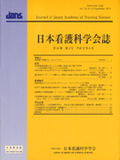Japanese
English
- 販売していません
- Abstract 文献概要
- 参考文献 Reference
- サイト内被引用 Cited by
要旨
目的:本研究は未破裂脳動脈瘤に対し自然経過観察を選択した人々の生活体験を明らかにし看護支援への示唆を得ることを目的とした.
方法:現象学的アプローチを用いて,未破裂脳動脈瘤を1年以上経過観察している人々を対象に非構造化面接調査を実施した.データ分析にはGiorgiの分析方法を用いた.
結果:17名の対象者から得られた質的データ分析の結果,21の本質的要素が抽出された.それらはさらに(1)診断・療養体験(2)対処・生活再構築(3)瘤と共に生きる,の3側面に分けられた.対象者は『拭い去れない不安感』を抱えながらも『少しずつ生活範囲を拡大する』『破裂のリスクを最小限にする』などのさまざまな対処を経て,最終的に『時と共に積み重なる自信と確証』を得ていた.また瘤と共に生きる側面は,『瘤を自分なりに捉え直す』『肯定的側面に目を向ける』『瘤との適度な距離を知り保つ』の3局面をたどっていた.
結論:予防行動と不安のバランス保持,捉え直しと肯定的側面への気付き,瘤との適度な距離の理解などの看護支援を併せたフォローアップを行うことが必要であることが示唆された.
Abstract
Objectives:The present study aimed to explore the daily experiences of patients with unruptured intracranial aneurysms through a wait-and-see approach and examining nursing support.
Methods:We employed a phenomenological approach and conducted a survey using unstructured interviews of patients with unruptured intracranial aneurysms who had been monitored for more than a year. Data were analysed using Giorgi's method of phenomenological analysis.
Results:The qualitative analysis of data gained from the 17 subjects revealed 20 essential factors. We divided these into 3 aspects: (1) diagnosis and treatment experiences, (2) coping and life restructuring, and (3) living with aneurysm. Subjects, though burdened with “anxiety that cannot be wiped away,” had coped with it in various ways including “gradually increasing the range of daily activities” or “minimizing the risk of rupture,” and ultimately gained “confidence and assurance that built up over time.” With respect to the particular aspect of ‘living with aneurysm,' we found that patients followed three phases, including “reinterpreting aneurysm in one's own way,” “looking at the positive aspects of the condition,” and “learning to keep an appropriate distance from aneurysm.”
Conclusions:We demonstrate the need for follow-up that incorporates nursing support. This support should maintain a balance between preventative action and anxiety, reinterpret and acknowledge the positive aspects of this condition, and help to define and understand an appropriate distance from aneurysm.
Copyright © 2010, Japan Academy of Nursing Science. All rights reserved.


